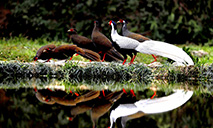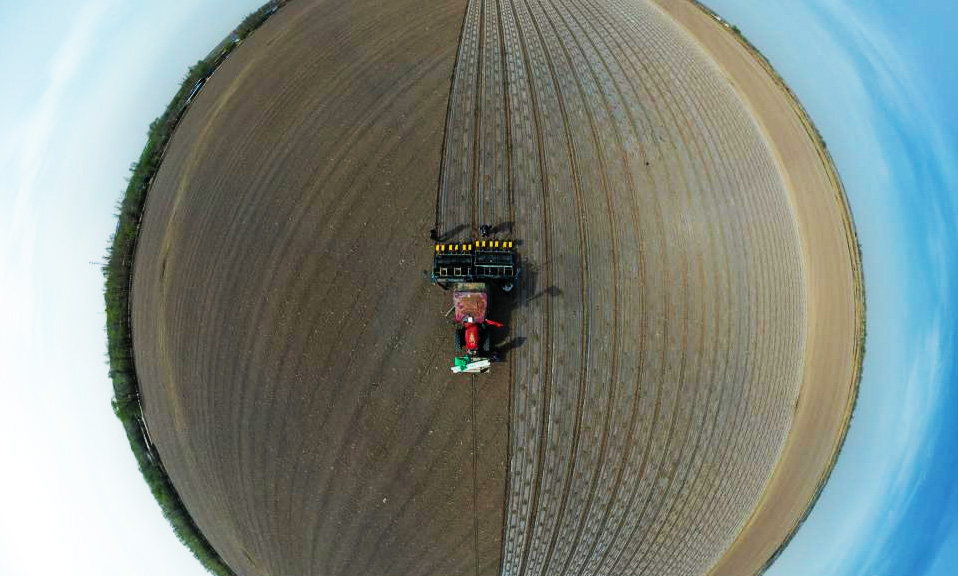Peering into China's national park construction from Hainan
BOAO, Hainan, April 24 (Xinhua) -- Walking into a virtual 3D tropical rainforest, guests attending the Boao Forum for Asia (BFA) Annual Conference 2022 in China's southernmost province of Hainan could see gibbons endemic to the island swinging between branches as if they were visiting an actual rainforest.
The province, where China has established its first batch of five national parks, held a cultural exhibition featuring its signature tropical rainforests during the forum from Wednesday to Friday.
The theme of Earth Day 2022, which falls on Friday, is "Invest In Our Planet." This year marks the 53rd anniversary of Earth Day, and the initiative calls for forging a partnership toward safeguarding the planet where everyone is accounted for and accountable.
The BFA's interactive arrangement gave the visitors an immersive experience through which they learn about the Hainan Tropical Rainforest National Park through their five senses.
With an overall protected area of 230,000 square km, the five national parks are home to nearly 30 percent of the key terrestrial wildlife species protected by China.
During a sub-forum of the BFA annual conference held on Thursday, Li Chunliang, deputy director of the National Forestry and Grassland Administration (NFGA), said that China plans to set up a new batch of national parks in locations of great ecological value, such as the Qinghai-Tibet Plateau, the Yellow River basin, and the Yangtze River basin.
The country will also select about 50 candidate areas for further national park construction, accounting for one-tenth of its land area. These regions will help protect China's most representative ecosystems and more than 80 percent of key wildlife under state protection and their habitats, said Li.
Currently, China's first five national parks have provided shelter for over 10,000 kinds of higher plants and nearly 1,600 animal species, including giant pandas, Siberian tigers, and snow leopards. It covers around 40,000 square km of forests, 150,000 square km of grasslands, and 15,000 square km of wetlands, said Ouyang Zhiyun, director of the Research Center for Eco-Environmental Sciences under the Chinese Academy of Sciences.
The value of ecological products provided by the five national parks, including water and soil conservation, is estimated to be around 1.08 trillion yuan (about 166 billion U.S. dollars), Ouyang added.
Hainan's national park, covering 4,269 square km, is home to China's most concentrated and well-preserved tropical rainforests. The park is also the only habitat of Hainan gibbons, a rare primate.
Many wildlife that had long disappeared are returning to their homes thanks to the park. The Hainan gibbon population has been restored to 36 on the island, while nine plant species have been newly discovered in the park's range.
Martin Raiser, the World Bank's country director for China, shared his views on the economic cost that may happen if people pay little attention to biodiversity conservation. He spoke via video link during the sub-forum "Dialogue in Hainan."
According to World Bank figures, developing tourism properly while protecting biodiversity can generate a return of 6 to 28 U.S. dollars for each dollar invested by the government.
Similar opinions and suggestions on improving national park planning and construction were also brought up by speakers from Brazil and other countries.
By 2025, China plans to improve its national park system, complete the integration and optimization of its nature reserve areas, and initially establish nature reserve areas with national parks as a major component, a move for the country to push forward sustainable development.
China has put forward a phased plan to improve the protection of nature reserve areas, planning to reach a world-leading management level and protection scale in this field by 2035. By that time, China's nature reserve areas are expected to account for more than 18 percent of its land areas.
Photos
 World Book Day: Let's read together
World Book Day: Let's read together Rare silver pheasants flock together in greater numbers to forage at Yishan nature reserve in east China's Jiangxi
Rare silver pheasants flock together in greater numbers to forage at Yishan nature reserve in east China's Jiangxi Young artist takes up brush to create lifelike paintings expressing mankind and nature’s harmonious co-existence
Young artist takes up brush to create lifelike paintings expressing mankind and nature’s harmonious co-existence Cutton farming in full swing in China's Xinjiang
Cutton farming in full swing in China's Xinjiang
Related Stories
Copyright © 2022 People's Daily Online. All Rights Reserved.






